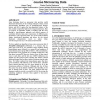Free Online Productivity Tools
i2Speak
i2Symbol
i2OCR
iTex2Img
iWeb2Print
iWeb2Shot
i2Type
iPdf2Split
iPdf2Merge
i2Bopomofo
i2Arabic
i2Style
i2Image
i2PDF
iLatex2Rtf
Sci2ools
SAC
2004
ACM
2004
ACM
Time-frequency feature detection for time-course microarray data
Gene clustering based on microarray data provides useful functional information to the working biologists. Many current gene-clustering algorithms rely on Euclidean-based distance metrics and fail to capture the time-dependent features of the data, usually corrupted by high levels of experimental noise. Here we propose an algorithm capable of dealing with the noise through a time-frequency approach and related measure of correlation between time-course expressions of different genes (trajectories). The approach makes use of fast multi-resolution feature classification algorithms and allows for the desired functional characteristics (such as phase delay, activation/repression etc.) to be enhanced and detected. We have applied our algorithm to time-course microarray data of Drosophila melanogaster (Arbeitman et al., Science, Sep 27, 2002, page 2270-2275). We examined various relations among homeodomain genes (referred to as group H) and regulators of homeodomain genes (group RH) as foll...
| Added | 30 Jun 2010 |
| Updated | 30 Jun 2010 |
| Type | Conference |
| Year | 2004 |
| Where | SAC |
| Authors | Jiawu Feng, Paolo Emilio Barbano, Bud Mishra |
Comments (0)

